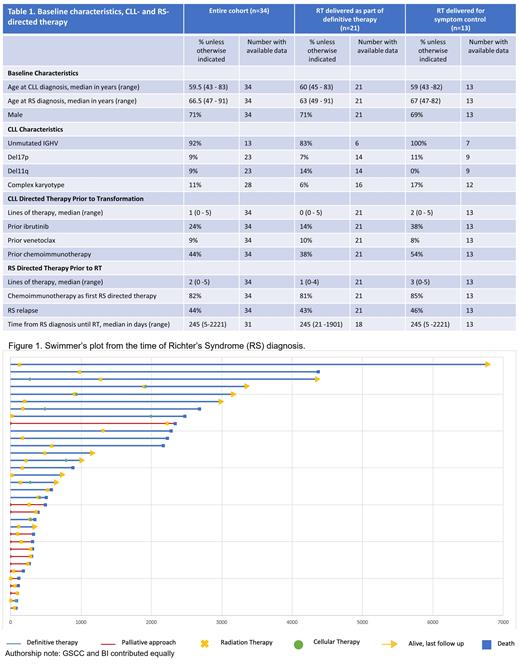Abstract
Introduction: The transformation of chronic lymphocytic leukemia (CLL) into a highly aggressive B-cell lymphoma histology, known as Richter's syndrome (RS), is associated with rapid progression and remains a serious treatment challenge. Standard chemoimmunotherapy approaches often yield poor response rates, short remission durations, and limited overall survival. The role of radiation therapy (RT) in the management of RS has not been explored, and decision making regarding the use of RT in RS is extrapolated from the de novo diffuse large B cell lymphoma (DLBCL) literature. Herein, we report, to the best of our knowledge, the largest case series of patients with RS who received RT.
Methods: We conducted a retrospective review of all patients Memorial Sloan Kettering Cancer Center diagnosed with DLBCL RS between April 2002 and August 2020 who received RT at any time following RS diagnosis. Baseline characteristics, information regarding CLL- and RS-directed therapy, RT characteristics including its therapeutic intent, and outcomes were collected. Progression free and overall survival (PFS, OS) were estimated using Kaplan Meier method. All other analyses were descriptive. Analyses were performed using STATA 17.0.
Results: 34 RS patients who received RT were identified. Twenty-one received RT as part of a definitive therapeutic strategy while 13 received RT solely for palliation. Baseline characteristics for the entire cohort, as well as divided by RT therapeutic intent, are described in Table 1. Patients received a median of 1 (range 0-5) prior line of CLL-directed therapy prior to RS diagnosis; 24% had prior ibrutinib while 9% had prior venetoclax. Patients received a median of 2 (range 0-5) lines of RS-directed therapy prior to RT; chemoimmunotherapy was first-line RS-directed therapy for 82%. Figure 1 depicts a swimmer's plot for all patients from time of RS diagnosis and includes timing of RT and cellular therapy (CAR-T or allogeneic stem cell transplant, alloSCT).
Heterogeneity in the parameters of radiation utilized reflected diverse clinical situations in this cohort. Across the cohort, most commonly irradiated areas included head and neck sites (n=11), abdomen (n=5), paraspinal (n=4) and pelvis/groin (n=4). Median delivered dose was 30.6 Gy (range: 18-54) and 25 Gy (range: 4.5-45) for the definitively and palliatively-treated patients, respectively. Four patients (3 palliative, 1 consolidative) did not complete prescribed course of RT.
We subsequently focused on 21 patients treated with RT as part of a definitive therapeutic strategy. With a median follow-up time of 5.8 (range 0.2 - 18.5) years, median OS was estimated to be 6.8 years from RS diagnosis. Fourteen patients (67%) experienced DLBCL progression following RT.
A subset of 12 patients received RT following chemoimmunotherapy without immediate cellular therapy in the front-line setting (58%; 7/12) or relapsed/refractory setting (42%; 5/12). Response at the time of RT was CR/clinical CR in 7 patients (58%), PR in 3 (25%), and PD in 1 (8%); response at the time of RT was unknown for 1 patient. In this subset, four (33%) experienced RS disease relapse with 2 occurring within the prior radiation field and 2 occurring distantly. Two patients received RT as an up-front therapy prior to any chemoimmunotherapy in the setting of localized disease. One of these two subsequently had a DLBCL relapse within the prior radiation field.
RT was used as a bridging strategy to cellular therapy in 7 patients including alloSCT (n=4) and CAR-T (n=3). Four patients experienced RS relapse. Estimated median PFS was 1.1 years and median OS was 1.9 years from time of cellular therapy.
Conclusion: In the largest single-institution series to describe the use of RT in RS, patients who received RT for the diagnosis of RS experienced favorable long-term survival when used as part of a definitive therapeutic strategy, including consolidation following chemoimmunotherapy and as bridging to cellular therapy. These data suggest a role for RT in the management of RS to be further explored through multicenter collaborations and prospective studies.
Thompson: VJHemOnc: Honoraria; Curio Science: Honoraria; MJH Life Sciences: Honoraria. Mato: Acerta/AstraZeneca: Consultancy, Research Funding; LOXO: Consultancy, Research Funding; Nurix: Research Funding; Sunesis: Consultancy, Research Funding; Adaptive Biotechnologies: Consultancy, Research Funding; AbbVie: Consultancy, Research Funding; BeiGene: Consultancy, Research Funding; Genentech: Consultancy, Research Funding; Pharmacyclics LLC, an AbbVie Company: Consultancy, Research Funding; Genmab: Research Funding; AstraZeneca: Consultancy; DTRM BioPharma: Consultancy, Research Funding; Janssen: Consultancy, Research Funding; Johnson and Johnson: Consultancy, Research Funding; TG Therapeutics: Consultancy, Other: DSMB, Research Funding; MSKCC: Current Employment. Roeker: AbbVie, AstraZeneca, Janssen, LOXO, Pharmacyclics, TG Therapeutics, Vaniam Group, Verastem: Consultancy; Pfizer: Consultancy, Research Funding; Pharmacyclics: Consultancy; TG Therapeutics: Consultancy; Loxo Oncology: Consultancy; Abbot Laboratories: Current equity holder in publicly-traded company.


This feature is available to Subscribers Only
Sign In or Create an Account Close Modal